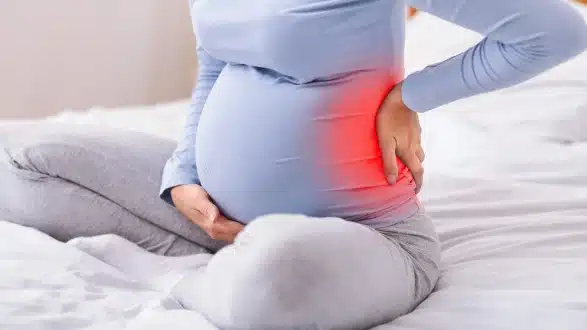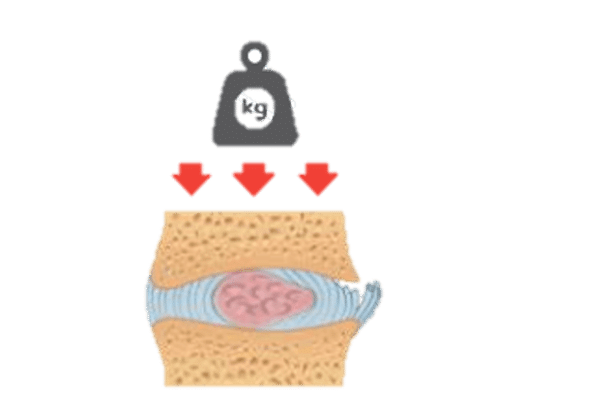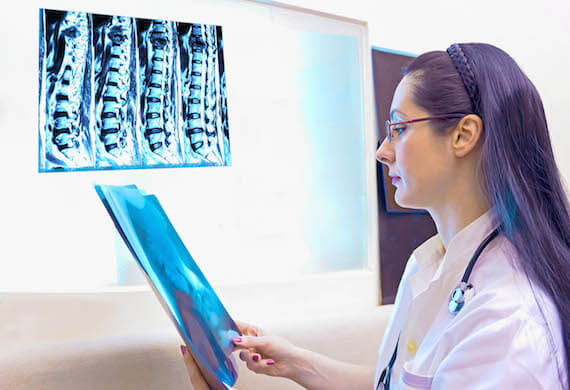Request Appointment
Enter your details and we will be in touch with you shortly;
Or call
8655885566
between 8 am and 8 pm.

Back pain during pregnancy due to instability in spinal muscle strength

During pregnancy, back pain usually affects the lower back or pelvic region due to the changes that occur in a woman’s body. As the uterus grows, the person’s balance shifts, making the lower back bend more and putting stress on both muscles and ligaments. As it prepares the body for birth, relaxin and other pregnancy hormones make the pelvic ligaments looser, which can also limit the spine’s stability. Many women benefit from pregnancy back pain relief therapy, including targeted stretches and stabilization exercises.
Pregnancy-related back pain is not a concern for the well-being of the baby. The uncomfortable sensations are caused by the mother’s changing muscles, not by uterine or placental changes. Effective pregnancy back pain treatment, such as posture education, supportive pillows, and gentle exercise, ensures maternal comfort without compromising fetal well-being. Being able to move easily and experience less pain during pregnancy and after the birth both make it easier for the mother.
By understanding what back pain during pregnancy is, its usual timetable, and its influence on everyday activities, pregnant women and their healthcare providers can use safe, evidence-based methods, from pregnancy back pain treatment to accommodative positioning, to provide adequate back pain relief during pregnancy and protect maternal and fetal health.
The type of prenatal back pain and the intensity can vary from one woman to the next, and women who experience this problem during their first pregnancy will be pre-disposed to back pain during subsequent pregnancies. Pregnancy back pain symptoms can include:
Tingling or numbness that moves from the lower back and down one or both legs (sciatica)
 Professional diagnosis required
Professional diagnosis required Chronic, can last for years
Chronic, can last for years Treatable with Throughout pregnancy
Treatable with Throughout pregnancyHormonal changes during pregnancy are the underlying cause of back pain during pregnancy. Pregnant women have high levels of the hormone relaxin, which loosens the ligaments in the pelvic area to prepare for childbirth. However, this hormone also loosens the ligaments in the spine, which leads to spinal instability and, therefore, back pain. It can take a while for these hormonal levels to come back to normal, which is why post-natal back pain is not uncommon. Some of the other causes of prenatal back pain include:
 Professional diagnosis required
Professional diagnosis required Chronic, can last for years
Chronic, can last for years Treatable with 4 weeks of QI Spine Therapy
Treatable with 4 weeks of QI Spine TherapyThere are limited treatment options for pregnancy back pain as the health and well-being of the unborn baby are of the utmost importance. Several allopathic pain medications have been linked to an increased risk of health problems for the mother as well as her child. However, QI’s unique holistic approach helps to reduce back pain in pregnancy without any risk to mother and child.
Thermotherapy is a simple but effective pain management method that is safe for pregnant women. In addition, QI spine specialists will provide ergonomic education and suggest postural changes, as posture correction reduces the amount of stress that falls on the spine. Medical movements that target core strengthening and improve spine alignment will help reduce and prevent back pain during pregnancy.
QI has a unique system that is built on over 47,000 past cases. This knowledge management system uses an algorithm to ensure that every patient receives a treatment plan that is best suited to his/her specific needs. Individualized treatment protocols for pregnancy back pain will drastically increase the effectiveness of the treatment plan. Pregnancy back pain is a common problem, but you don’t have to suffer through it. Consult a spine specialist to reduce your pain and enjoy every moment of this magical experience.
Below are safe, practical exercises to support pregnancy back pain treatment and enhance your pregnancy back pain therapy routine. Move slowly, take deep breaths, and stop any exercise if you feel discomfort. Try not to do any of the exercises until you have direction from someone. Here are the exercises to follow:
Incorporating these back pain exercises for pregnant women into your daily routine promotes pregnancy pain relief, improves core stability, and supports pelvic alignment for a more comfortable pregnancy.
Many women feel back pain during pregnancy; however, taking steps early on can lessen it. Here are some helpful recommendations, in point form, to keep you comfortable and mobile.
By integrating these strategies into your daily routine, you can achieve effective pregnancy back pain relief and support both your comfort and your baby’s well‑being.
 Professional diagnosis required
Professional diagnosis required Chronic, can last for years
Chronic, can last for years Treatable with 4 weeks of QI Spine Therapy
Treatable with 4 weeks of QI Spine TherapyThere are limited treatment options for pregnancy back pain as the health and wellbeing of the unborn baby is of the utmost importance. Several allopathic pain medications have been linked to an increased risk of health problems for the mother as well as her child. However, QI’s unique holistic approach helps to reduce back pain in pregnancy without any risk to mother and child.
 Professional diagnosis required
Professional diagnosis required Chronic, can last for years
Chronic, can last for years Treatable with 4 weeks of QI Spine Therapy
Treatable with 4 weeks of QI Spine TherapyDiagnosing back pain during pregnancy requires a careful balance of maternal safety and accurate assessment. A structured approach ensures that both common musculoskeletal causes and rare but serious conditions are identified.
Once non‑serious causes are confirmed, individualized pregnancy back pain relief treatment, including posture education, supportive maternity cushions, and gentle back pain exercises for pregnant women, can be implemented to achieve effective pregnancy-related back pain relief.
At QI Spine, the diagnosis is made by understanding first the patient’s history, conducting a thorough physical examination, and doing a DSA (Digital Spine Analysis test), which helps analyze the root cause of the problem. It is a non-invasive functional test that helps in measuring spine function. Its controlled and guided movements help determine the spine's mobility, strength, and imbalances of muscles around the spine.
CT scans, MRIs, and X-rays often fail to pinpoint the exact source of pain, whereas DSA directly analyzes muscle tissue to identify the root cause. Here is how DSA is conducted & its benefits:
 Professional diagnosis required
Professional diagnosis required Chronic, can last for years
Chronic, can last for years Treatable with 4 weeks of QI Spine Therapy
Treatable with 4 weeks of QI Spine Therapy


Have a question?
Ask our spine specialists
Who is a QI Spine Specialist?
A QI Spine Specialist is a medical expert with

Dr. Nidhi Sanghvi Shah

Dr. Shital Gaikwad

Dr. Richa Bhatia
9000 hours
of specialisation in treating back and neck conditions
32 hours
of spine physiotherapy specialisation methods in McKenzie concepts, Kinetic control, Neurodynamic solutions, Mulligan’s concepts
500 hours
and 6 months of QI Spine specialisation courses
Pregnancy back pain treatment often includes low-impact exercises, prenatal yoga, supportive footwear, and posture correction. Pregnancy back pain therapy, like prenatal physical therapy, can also offer effective relief.
Abdominal pain, heavy bleeding, rapid swelling, a high temperature, and reduced fetal activity should be taken seriously. Any person with these symptoms should see a doctor as soon as possible.
Common problems for pregnant women are round ligament pain, lower back pain, and feeling pressure in the pelvic area. These are typically managed with rest, gentle stretching, and pregnancy-related back pain relief strategies.
During pregnancy, back pain can start between the 18th and 24th weeks. Pain usually increases in the third trimester because of extra weight and hormone shifts that affect ligaments and posture.
Supportive pregnancy cushions and maternity belts help redistribute weight, relieve lower back strain, and improve posture. Studies show that they can reduce discomfort in over 60% of pregnant women who use them consistently.